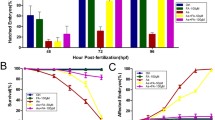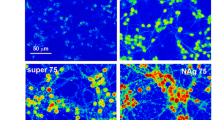Abstract
ZnT-1 reduces intracellular zinc accumulation and confers resistance against cadmium toxicity by a mechanism which is still unresolved. A functional link between the L-type calcium channels (LTCC) and ZnT-1 has been suggested, indicating that ZnT-1 may regulate ion permeation through this pathway. In the present study, immunohistochemical analysis revealed a striking overlap of the expression pattern of LTCC and ZnT-1 in cardiac tissue and brain. Using siRNA to silence ZnT-1 expression, we then assessed the role of ZnT-1 in regulating cation permeation through the L-type Ca2+ channels in cells that are vulnerable to heavy metal permeation. Transfection of cortical neurons with ZnT-1 siRNA resulted in about 70% reduction of ZnT-1 expression and increased Ca2+ influx via LTCC by approximately fourfold. Moreover, ZnT-1 siRNA transfected neurons showed ∼30% increase in synaptic release, monitored using the FM1-43 dye. An increased cation influx rate, through the LTCC, was also recorded for Zn2+ and Cd2+ in cells treated with the ZnT-1 siRNA. Furthermore, Cd2+-induced neuronal death increased by approximately twofold after transfection with ZnT-1 siRNA. In addition, ZnT-1 siRNA transfection of the ovarian granulosa cell line, POGRS1, resulted in a twofold increase in Cd2+ influx rate via the LTCC. Finally, a robust nimodipine-sensitive Cd2+ influx was observed using a low extracellular Cd2+ concentration (5 μM) in neurons and testicular slice cultures, attesting to the relevance of the LTCC pathway to heavy metal toxicity. Taken together, our results indicate that endogenously-expressed ZnT-1, by modulating LTCC, has a dual role: regulating calcium influx, and attenuating Cd2+ and Zn2+ permeation and toxicity in neurons and other cell types.







Similar content being viewed by others
Abbreviations
- LTCC:
-
L-type calcium channels
- siRNA:
-
small interfering RNA
- MT:
-
Metallothionein
- TPEN,N,N,N′,N′:
-
Tetrakis(2-pyrifylmethyl)ethyllenediamine
- SDS:
-
Sodium dodecyl sulfate
- LDH:
-
Lactate dehydrogenase
References
Palmiter RD, Findley SD (1995) Cloning and functional characterization of a mammalian zinc transporter that confers resistance to zinc. EMBO-J 14:639–649
Nolte C, Gore A, Sekler I, Kresse W, Hershfinkel M, Hoffmann A, Kettenmann H, Moran A (2004) ZnT-1 expression in astroglial cells protects against zinc toxicity and slows the accumulation of intracellular zinc. Glia 48:145–155
Segal D, Ohana E, Besser L, Hershfinkel M, Moran A, Sekler I (2004) A role for ZnT-1 in regulating cellular cation influx. Biochem Biophys Res Commun 323:1145–1150
Atar D, Backx PH, Appel MM, Gao WD, Marban E (1995) Excitation–transcription coupling mediated by zinc influx through voltage-dependent calcium channels. J Biol Chem 270:2473–2477
Sensi SL, Canzoniero LM, Yu SP, Ying HS, Koh JY, Kerchner GA, Choi DW (1997) Measurement of intracellular free zinc in living cortical neurons: routes of entry. J Neurosci 17:9554–9564
Usai C, Barberis A, Moccagatta L, Marchetti C (1999) Pathways of cadmium influx in mammalian neurons. J Neurochem 72:2154–2161
Choi DW (1996) Zinc neurotoxicity may contribute to selective neuronal death following transient global cerebral ischemia. Cold Spring Harbor Symp Quant Biol 61:385–387
Cherny RA, Barnham KJ, Lynch T, Volitakis I, Li QX, McLean CA, Multhaup G, Beyreuther K, Tanzi RE, Masters CL, Bush AI (2000) Chelation and intercalation: complementary properties in a compound for the treatment of Alzheimer’s disease. J Struct Biol 130:209–216
Fern R, Black JA, Ransom BR, Waxman SG (1996) Cd(2+)-induced injury in CNS white matter. J Neurophysiol 76:3264–3273
Benoff S, Jacob A, Hurley IR (2000) Male infertility and environmental exposure to lead and cadmium. Hum Reprod Update 6:107–121
Pant N, Upadhyay G, Pandey S, Mathur N, Saxena DK, Srivastava SP, Xu LC, Wang SY, Yang XF, Wang XR (2003) Lead and cadmium concentration in the seminal plasma of men in the general population: correlation with sperm quality. Reprod Toxicol 17:447–450
Johnson MD, Kenney N, Stoica A, Hilakivi-Clarke L, Singh B, Chepko G, Clarke R, Sholler PF, Lirio AA, Foss C, Reiter R, Trock B, Paik S, Martin MB (2003) Cadmium mimics the in vivo effects of estrogen in the uterus and mammary gland. Nat Med 9:1081–1084
Hasumi M, Suzuki K, Matsui H, Koike H, Ito K, Yamanaka H (2003) Regulation of metallothionein and zinc transporter expression in human prostate cancer cells and tissues. Cancer Lett 200:187–195
Andrews GK (2001) Cellular zinc sensors: MTF-1 regulation of gene expression. BioMetals 14:223–237
Takiguchi M, Cherrington NJ, Hartley DP, Klaassen CD, Waalkes MP (2001) Cyproterone acetate induces a cellular tolerance to cadmium in rat liver epithelial cells involving reduced cadmium accumulation. Toxicology 165:13–25
Trebak M, Vazquez G, Bird GS, Putney JW Jr (2003) The TRPC3/6/7 subfamily of cation channels. Cell Calcium 33:451–461
Andrews GK, Wang H, Dey SK, Palmiter RD (2004) Mouse zinc transporter 1 gene provides an essential function during early embryonic development. Genesis 40:74–81
Moss EG, Taylor JM (2003) Small-interfering RNAs in the radar of the interferon system. Nat Cell Biol 5:771–772
Ohana E, Segal D, Palty R, Ton-That D, Moran A, Sensi SL, Weiss JH, Hershfinkel M, Sekler I (2004) A sodium zinc exchange mechanism is mediating extrusion of zinc in mammalian cells. J Biol Chem 279:4278–4284
Selvaraj N, Israeli D, Amsterdam A (1996) Partial sequencing of the rat steroidogenic acute regulatory protein message from immortalized granulosa cells: regulation by gonadotropins and isoproterenol. Mol Cell Endocrinol 123:171–177
Nitzan YB, Sekler I, Hershfinkel M, Moran A, Silverman WF (2002) Postnatal regulation of ZnT-1 expression in the mouse brain. Brain Res Dev Brain Res 137:149–157
Sekler I, Moran A, Hershfinkel M, Dori A, Margulis A, Birenzweig N, Nitzan Y, Silverman WF (2002) Distribution of the zinc transporter ZnT-1 in comparison with chelatable zinc in the mouse brain. J Comp Neurol 447:201–209
Hershfinkel M, Moran A, Grossman N, Sekler I (2001) A zinc-sensing receptor triggers the release of intracellular Ca2+ and regulates ion transport. Proc Natl Acad Sci USA 98:11749–11754
Markwell MA, Haas SM, Bieber LL, Tolbert NE (1978) A modification of the Lowry procedure to simplify protein determination in membrane and lipoprotein samples. Anal Biochem 87:206–210
Betz WJ, Mao F, Smith CB (1996) Imaging exocytosis and endocytosis. Curr Opin Neurobiol 6:365–371
Cove J, Blinder P, Abi-Jaoude E, Lafreniere-Roula M, Devroye L, Baranes D (2006) Growth of neurites toward neurite–neurite contact sites increases synaptic clustering and secretion and is regulated by synaptic activity. Cereb Cortex 16:83–92
Catterall WA (2000) Structure and regulation of voltage-gated Ca2+ channels. Annu Rev Cell Dev Biol 16:521–555
Takagishi Y, Yasui K, Severs NJ, Murata Y (2000) Species-specific difference in distribution of voltage-gated L-type Ca(2+) channels of cardiac myocytes. Am J Physiol Cell Physiol 279:C1963–C1969
Lipscombe D, Helton TD, Xu W (2004) L-type calcium channels: the low down. J Neurophysiol 92:2633–2641
Wu LG, Westenbroek RE, Borst JG, Catterall WA, Sakmann B (1999) Calcium channel types with distinct presynaptic localization couple differentially to transmitter release in single calyx-type synapses. J Neurosci 19:726–736
Obermair GJ, Szabo Z, Bourinet E, Flucher BE (2004) Differential targeting of the L-type Ca2+ channel alpha 1C (CaV1.2) to synaptic and extrasynaptic compartments in hippocampal neurons. Eur J Neurosci 19:2109–2122
Tokunaga T, Miyazaki K, Koseki M, Mobarakeh JI, Ishizuka T, Yawo H (2004) Pharmacological dissection of calcium channel subtype-related components of strontium inflow in large mossy fiber boutons of mouse hippocampus. Hippocampus 14:570–585
Urbano FJ, Depetris RS, Uchitel OD (2001) Coupling of L-type calcium channels to neurotransmitter release at mouse motor nerve terminals. Pflugers Arch 441:824–831
Benoff S, Goodwin LO, Millan C, Hurley IR, Pergolizzi RG, Marmar JL (2005) Deletions in L-type calcium channel alpha1 subunit testicular transcripts correlate with testicular cadmium and apoptosis in infertile men with varicoceles. Fertil Steril 83:622–634
Grunnet M, Kaufmann WA (2004) Coassembly of big conductance Ca2+-activated K+ channels and L-type voltage-gated Ca2+ channels in rat brain. J Biol Chem 279:36445–36453
Kobayashi T, Mori Y (1998) Ca2+ channel antagonists and neuroprotection from cerebral ischemia. Eur J Pharmacol 363:1–15
Jirakulaporn T, Muslin AJ (2004) Cation diffusion facilitator proteins modulate Raf-1 activity. J Biol Chem 279:27807–27815
Illario M, Cavallo AL, Bayer KU, Di Matola T, Fenzi G, Rossi G, Vitale M (2003) Calcium/calmodulin-dependent protein kinase II binds to Raf-1 and modulates integrin-stimulated ERK activation. J Biol Chem 278:45101–45108
Dumaz N, Marais R (2003) Protein kinase A blocks Raf-1 activity by stimulating 14-3-3 binding and blocking Raf-1 interaction with Ras. J Biol Chem 278:29819–29823
Lorenz K, Lohse MJ, Quitterer U (2003) Protein kinase C switches the Raf kinase inhibitor from Raf-1 to GRK-2. Nature 426:574–579
Liuzzi JP, Cousins RJ (2004) Mammalian zinc transporters. Annu Rev Nutr 24:151–172
Palmiter RD, Cole TB, Quaife CJ, Findley SD (1996) ZnT-3, a putative transporter of zinc into synaptic vesicles. Proc Natl Acad Sci USA 93:14934–14939
MacDiarmid CW, Milanick MA, Eide DJ (2002) Biochemical properties of vacuolar zinc transport systems of Saccharomyces cerevisiae. J Biol Chem 277:39187–39194
Hell JW, Westenbroek RE, Warner C, Ahlijanian MK, Prystay W, Gilbert MM, Snutch TP, Catterall WA (1993) Identification and differential subcellular localization of the neuronal class C and class D L-type calcium channel alpha 1 subunits. J Cell Biol 123:949–962
Waters J, Smith SJ (2000) Phorbol esters potentiate evoked and spontaneous release by different presynaptic mechanisms. J Neurosci 20:7863–7870
Petzold GC, Scheibe F, Braun JS, Freyer D, Priller J, Dirnagl U, Dreier JP (2005) Nitric oxide modulates calcium entry through P/Q-type calcium channels and N-methyl-d-aspartate receptors in rat cortical neurons. Brain Res 1063:9–14
Chen J, Daggett H, De Waard M, Heinemann SH, Hoshi T (2002) Nitric oxide augments voltage-gated P/Q-type Ca(2+) channels constituting a putative positive feedback loop. Free Radic Biol Med 32:638–649
Choi DW, Koh JY (1998) Zinc and brain injury. Annu Rev Neurosci 21:347–375
Yagami T, Ueda K, Sakaeda T, Itoh N, Sakaguchi G, Okamura N, Hori Y, Fujimoto M (2004) Protective effects of a selective L-type voltage-sensitive calcium channel blocker, S-312-d, on neuronal cell death. Biochem Pharmacol 67:1153–1165
Tsushima RG, Wickenden AD, Bouchard RA, Oudit GY, Liu PP, Backx PH (1999) Modulation of iron uptake in heart by L-type Ca2+ channel modifiers: possible implications in iron overload. Circ Res 84:1302–1309
Oudit GY, Sun H, Trivieri MG, Koch SE, Dawood F, Ackerley C, Yazdanpanah M, Wilson GJ, Schwartz A, Liu PP, Backx PH (2003) L-type Ca2+ channels provide a major pathway for iron entry into cardiomyocytes in iron-overload cardiomyopathy. Nat Med 9:1187–1194
Inoue K, Matsuda K, Itoh M, Kawaguchi H, Tomoike H, Aoyagi T, Nagai R, Hori M, Nakamura Y, Tanaka T (2002) Osteopenia and male-specific sudden cardiac death in mice lacking a zinc transporter gene, Znt5. Hum Mol Genet 11:1775–1784
Xiao GQ, Hu K, Boutjdir M (2001) Direct inhibition of expressed cardiac l- and t-type calcium channels by IgG from mothers whose children have congenital heart block. Circulation 103:1599–1604
Dalton TP, He L, Wang B, Miller ML, Jin L, Stringer KF, Chang X, Baxter CS, Nebert DW (2005) Identification of mouse SLC39A8 as the transporter responsible for cadmium-induced toxicity in the testis. Proc Natl Acad Sci USA 102:3401–3406
Fernandez EL, Gustafson AL, Andersson M, Hellman B, Dencker L (2003) Cadmium-induced changes in apoptotic gene expression levels and DNA damage in mouse embryos are blocked by zinc. Toxicol Sci 76:162–170
Tang W, Sadovic S, Shaikh ZA (1998) Nephrotoxicity of cadmium-metallothionein: protection by zinc and role of glutathione. Toxicol Appl Pharmacol 151:276–282
Maret W (2003) Cellular zinc and redox states converge in the metallothionein/thionein pair. J Nutr 133:1460S–1462S
Sensi SL, Ton-That D, Sullivan PG, Jonas EA, Gee KR, Kaczmarek LK, Weiss JH (2003) Modulation of mitochondrial function by endogenous Zn2+ pools. Proc Natl Acad Sci USA 100:6157–6162
Acknowledgements
We thank the fellowship generously donated by Daniel Falkner to E.O. This work was partially supported by the ISF (to I.S. and to W.F.S.) and the BSF (to M.H.) and by the BG Negev (to I.S. and M.H). We also thank Dr. Daniel Gitler for his invaluable advice on the analysis of the synaptic transmission data.
Author information
Authors and Affiliations
Corresponding author
Rights and permissions
About this article
Cite this article
Ohana, E., Sekler, I., Kaisman, T. et al. Silencing of ZnT-1 expression enhances heavy metal influx and toxicity. J Mol Med 84, 753–763 (2006). https://doi.org/10.1007/s00109-006-0062-4
Received:
Accepted:
Published:
Issue Date:
DOI: https://doi.org/10.1007/s00109-006-0062-4




